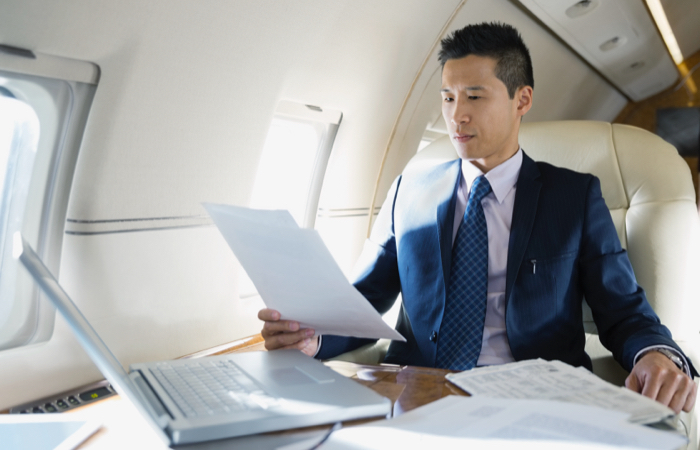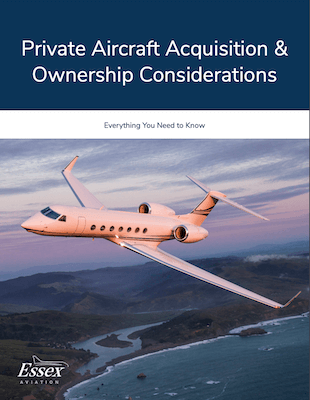
When purchasing an aircraft, you want to be sure you’re getting a fair or current market price. You’d also like to be confident that the seller is being candid about their valuation; you don’t want to find out after the fact that you could have paid far less than the aircraft was worth.
In the private aircraft acquisitions market, aircraft appraisers can assist with the validation on a seller’s or broker’s asking price, providing appraisals based on pricing guide analysis and guidance from the Professional Aircraft Appraisal Organization (PAAO). It’s their job to determine the fair market value of an aircraft for brokers and owners alike, ensuring transparency during the sales process.
What Is an Aircraft Appraisal?
An aircraft appraisal is an impartial assessment of an aircraft’s current market value, as determined through a valuation process conducted by a certified appraiser. A majority of aircraft appraisers are accredited by the American Society of Appraisers (ASA) and trained to evaluate all the elements that may affect an aircraft’s value. Following consultation with an appraiser, the seller can then generate a fair and accurate retail price.
Key Components of an Appraisal
Appraisers leave no stone unturned when assessing an aircraft’s true value:
- Year, make and model: Just like a car, the market value of an aircraft is affected by its model as well as its year of manufacture.
- Avionics and other navigational equipment: In general, newer, more high-tech electronic equipment and systems are valued above older instruments. These include communications, flight controls, monitoring, collision avoidance, field and weather equipment and systems.
- Interior and exterior condition: Appraisers look for internal and external damage or evidence of wear-and-tear. Any prior or recent aircraft refurbishments are also considered.
- Cabin management systems/equipment: As with avionics, an up-to-date cabin management system and interface will likely be valued higher than an older system.
- Internet service: Wi-Fi is practically a necessity on today’s aircraft, so the presence and quality of an internet system is a key consideration.
- Engine and airframe time: This parameter is equivalent to a car’s mileage. Total flight hours and cycles are all considered, as they will have an impact on maintenance predictions.
- Logbooks: All logbooks must be complete, up-to-date and accessible. Missing or incomplete logbooks will significantly decrease an aircraft’s value.
- Geographical location: Different regions impose different climate conditions on aircraft, which can affect the overall condition and on-going care of the aircraft. Internationally based or registered aircraft will require further review for a U.S. buyer to determine if any additional work is needed in order to move the aircraft onto the U.S. Registry.
- Prior damage history: Some level of normal wear-and-tear is expected for pre-owned aircraft, but significant damage and repairs could lower its value.
- Current market values and transactions: Appraisers will review recent transactions of similar aircraft as a comparison for their valuation estimate.
The 3 Main Categories of Aircraft Appraisals
Appraisers follow one of three processes when determining aircraft value: a pricing digest, desktop appraisal or physical appraisal.
- Pricing digest valuation: Consulting an industry pricing digest such as the Aircraft Bluebook or VREF is the most efficient and cost-effective way for frequent users to appraise an aircraft. That said, pricing digest valuations can be influenced by the market data they may not be able to obtain. The values can also leave out aircraft-specific nuances such as refurbishments or the age of the avionics which may not be fully known by the party running the valuation.
- Desktop appraisal: Pricing digests usually provide an accurate enough valuation for standard aircraft, which is why certified appraisers often use them as a starting point for further analysis and market research. Desktop appraisers will consider current market demand, trends and any upcoming maintenance. Since there is more legwork involved, a desktop appraisal requires an investment of around $2,500–$4,000.
- Physical appraisal: The most labor-intensive of them all, physical appraisals involve an in-person assessment of the aircraft to verify its condition. This is the most reliable way to get an accurate valuation for unique or highly modified aircraft. It requires a higher investment, typically around $6,000–$8,000, plus the travel costs for the party performing the on-site review.
When Should You Conduct an Aircraft Appraisal?
Aircraft appraisals provide clarity for not only buyers and sellers, but for lenders and insurers as well. Situations that might necessitate an appraisal include:
- Purchasing a pre-owned aircraft: Appraisals are standard practice for pre-owned acquisitions with financing, and are conducted or handled by the buyer’s lender (their bank).
- Selling an aircraft: Sellers may hire an appraiser to ensure they are asking a current market price.
- Loans on an aircraft: Aircraft lenders may require annual valuation as part of a review of a loan to value covenant.
- Selling a share of your private aircraft: Before selling private shares of their aircraft, sellers may want to request an appraisal to ensure they are getting the most value out of shared ownership.
- Reevaluating or changing insurance: An aircraft’s insurance coverage is partly based on its current value, and changing carriers or levels of coverage may require an appraisal.
What Does the Aircraft Appraisal Process Entail?
The appraisal process will vary depending on the appraiser and the specific aircraft, but each appraisal follows the same general procedure.
- The appraiser establishes the purpose of the appraisal, determines the scope of the work required and generates a quote for their services.
- First, the appraiser pulls public and market-related information about the aircraft to serve as a foundation for data modeling.
- If the appraiser is thorough, or if the aircraft is unique, they will schedule an appointment with the seller to view the aircraft(s) and any associated records.
- The appraiser conducts an onsite visit, taking photos and reviewing and digitizing the logbook (if necessary).
- They will follow up with the seller or any previous owners regarding open items, such as incomplete or missing logbooks.
- Once all information is obtained, the appraiser conducts an analysis of their findings and available data and generates a value.
- They then write up their final appraisal report and format it according to legal standards and specifications.
- Finally, the appraiser delivers the completed appraisal report to the client.
At Essex Aviation, we work hard to ensure our clients get the fairest and most accurate prices possible. Our expert team can help aircraft owners identify a qualified appraiser to conduct an in-depth assessment using best practices and the most up-to-date market data.
Before your next purchase (or if you’re new to aircraft acquisition) consult our comprehensive buyer’s guide: Questions You Should Be Asking Before Making Your Next Aviation Decision. Don’t hesitate to reach out for further guidance.
Aircraft Appraisal FAQs
How long does an appraisal take?
It depends on the type of appraisal. Pricing digest proposals can be generated in a matter of minutes, while a physical appraisal can take anywhere from a few days to over a week to generate (factor in a day or two for travel, two days for the physical inspection and time to complete the analysis and report).
How do you determine the value of an aircraft?
Aircraft valuation is determined by many factors, including:
- Year, make, model
- Physical condition
- Systems and equipment
- Damage and repair history
- Maintenance requirements
- Logbook condition
- Total hours and cycles
- Internet service
- Geographical location
Why isn’t an aircraft price guide sufficient for an aircraft appraisal?
Pricing digests are accurate enough for standard aircraft models, but the values can leave out aircraft-specific nuances such as refurbishments or the age of the avionics. Without further inspection or analysis against comparable aircraft, price guide appraisals risk missing key factors.
Is a physical inspection of the aircraft necessary for an accurate appraisal?
Physical appraisals will generate the most accurate valuation possible, especially for a unique or highly modified aircraft. Desktop appraisals and pricing guide appraisals are usually sufficient for most standard (unmodified, undamaged) aircraft, but especially meticulous buyers or lenders will request a physical appraisal for an airtight valuation.







